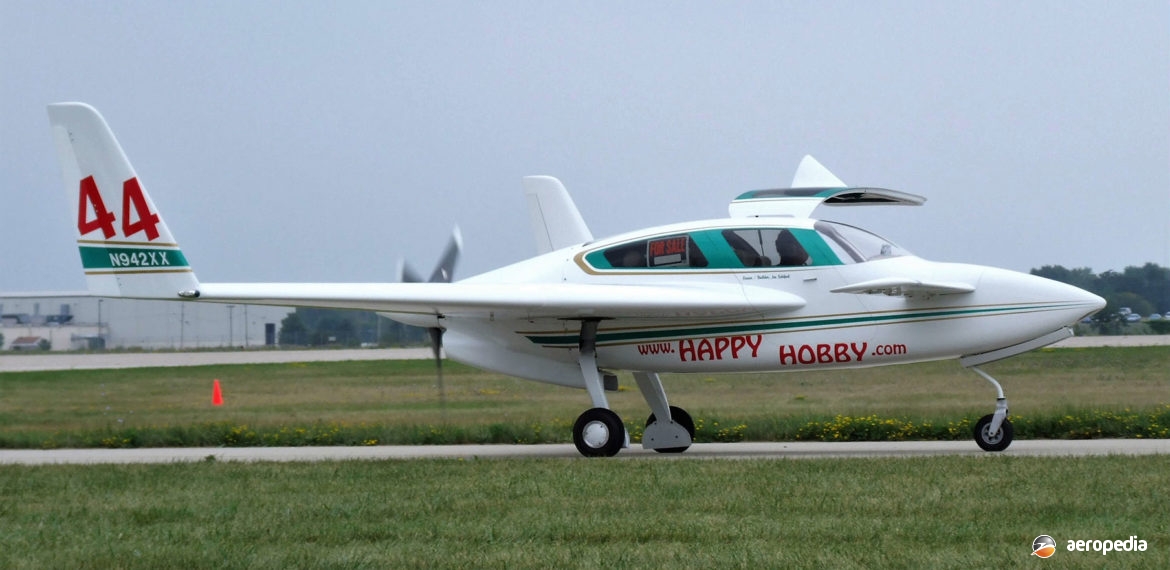Photograph:
Velocity 173/RG-E N942XX (c/n DMO369) at Oshkosh, Wisconsin,USA in July 2007 (David C Eyre)
Country of origin:
United States of America
Description:
Four-seat cabin monoplane
Power Plant:
One 194 kw (260 hp) Lycoming IO-540 six-cylinder horizontally-opposed air-cooled engine
Specifications:
- Wingspan: 9.44 m (31 ft)
- Length: 6.09 m (20 ft)
- Height: 2.4 m (7 ft 9 in)
- Wing area: 11.38 m² (122.5 sq ft)
- Max speed: 384 km/h (239 mph)
- Max cruising speed: 367 km/h (228 mph)
- Stalling speed: 120 km/h (75 mph)
- Rate of climb: 365 m/min (1,200 ft/min)
- Service ceiling: 6,096 m (20,000 ft)
- Range: 1,786 km (1,110 miles)
- Empty weight: 744 kg (1,640 lb)
- Loaded weight: 1,225 kg (2,700 lb)
History:
The Velocity has been marketed in kit form by Velocity Aircraft of Sebastian, Florida, USA as a high-performance touring aircraft seating four. The Velocity was designed and built by Danial Maher in 1984 as a four-seat canard aircraft based upon the Long-Ez design. The prototype first flew in July 1985 and later the type became available in kit form.
Eventually ownership of the Company was transferred to the Swing family and it was later produced in a number of variants, including the 173RG, the Elite RG, both of which had a 149 kw (200 hp) Lycoming IO-360 engine; and the Velocity XL with an IO-540 unit. It could be fitted with a fixed or retractable undercarriage, and gull-wing doors were standard. Engines ranging in power up to 224 kw (300 hp) could be fitted. Subsequently the Velocity LW was released, this being known as the ‘long wing’, having a larger wing of 20% longer canard span than the Elite, this providing lower landing speeds and more neutral stability.
The Model SUV had the 119 kw (160 hp) Lycoming O-320 engine, this model differing from the more powerful models in having a single door on the pilot’s side in lieu of the gull-wing doors, and control yokes for both pilots. This model could also be fitted with a 164 kw (220 hp) Franklin unit. Quick-build kits were available of all models.
Looking similar to Rutan designs, the Velocity was of fibreglass construction and utilised a canard wing. It could be fitted with either a fixed or retractable undercarriage. The Elite LW model was introduced in 1992, this having a larger wing and more docile flying characteristics. In the Elite XL, introduced in 1997, the aircraft was longer and wider, allowing the installation of engines in the 194 kw (260 hp) to 224 kw (300 hp) range with a resultant increase in performance. This mode’s fuel capacity was 266 litres (58 Imp gals) but this could be increased to 378 litres (83 Imp gals). All models later had an option for a retractable undercarriage. Design loads were +12 and –9 G. In 1999 the SUV model was released, this being an entry-level kit with a fixed undercarriage.
At least five kits are known to have been imported into Australia, the first being completed in western Sydney as VH-XLV (c/n N474), a model XL, registration being issued on 28 October 1998, but this aircraft was later exported to the United States in December 2003 where it became N32XL. A second aircraft was registered in Western Australia in mid-2002. A Model S-90 became VH-FRG² (c/n 99-00-06-M) and was registered on 23 April 2003, this aircraft being fitted with a Chevrolet LS.2 converted V-8 piston engine driving a MT German-built fibreglass-coated propeller made from laminated timber. VH-FRG² had a gross weight of 1,545 kg (3,406 lb), a cruising speed of 333 km/h (207 mph) and a range of 2,667 km (1,657 miles).

